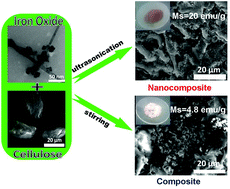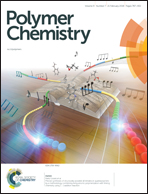Ferromagnetic iron oxide–cellulose nanocomposites prepared by ultrasonication†
Abstract
This paper highlights the efficiency of ultrasonication, as a clean and energy-saving method for the preparation of cellulose–iron oxide ferromagnetic composites in two steps. Hydroxyl-functionalized maghemite–goethite nanoparticles (MG) having a saturation magnetization of 56.9 emu g−1 at room temperature were first synthesized by a one-pot procedure involving ultrasonication of an aqueous alkaline Fe2+ salt solution. Organic–inorganic nanocomposites were obtained by a second ultrasonication step of an aqueous suspension of micronized cellulose and MG nanoparticles. The cumulative effect of ultrasonication and MG nano-projectiles was found to strongly decrease the degree of crystallinity of cellulose. The microstructural characterisation of the resulting composite evidenced its size polydispersity, with small nanoparticles uniformly attached on the surface of cellulose microfibrils. Vibrating sample magnetic measurement indicated a hysteresis curve specific to ferromagnetic materials and the appearance of a superparamagnetic phenomenon at low temperature (a blocking temperature of 62 K). Cellulose/iron oxide clusters with an average size around 7 nm and characterized by high decomposition temperatures (around 645 °C) were proven to be responsible for the observed superparamagnetic phenomenon. The superiority of the ultrasonication process versus a procedure involving simple mechanical stirring, in terms of composite yield, dispersion uniformity of MG nanoparticles and magnetic properties is discussed.

- This article is part of the themed collection: Frontiers in Supramolecular and Macromolecular Science symposia


 Please wait while we load your content...
Please wait while we load your content...